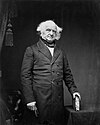Free Soil Party
Free Soil Party | |
|---|---|
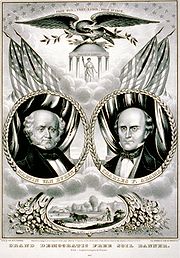 Martin Van Buren/Charles Francis Adamscampaign banner | |
| Leader | |
| Founded | 1848 |
| Dissolved | 1854 |
| Merger of | |
| Split from | Liberty Party |
| Merged into | Republican Party |
| Headquarters | Buffalo, New York |
| Newspaper | Free Soil Banner |
| Ideology | Anti-slavery[a] |
| Slogan | "Free Soil, Free Labor, Free Men"[1][2] |
TheFree Soil Partywas a short-lived coalitionpolitical partyin theUnited Statesactive from 1848 to 1854, when it merged into theRepublican Party.The party was largely focused on thesingle issueof opposing the expansion ofslaveryinto the westernterritories of the United States.
The Free Soil Party formed during the1848 presidential election,which took place in the aftermath of theMexican–American Warand debates over the extension of slavery into theMexican Cession.After theWhig Partyand theDemocratic Partynominated presidential candidates who were unwilling to rule out the extension of slavery into the Mexican Cession, anti-slavery Democrats and Whigs joined with members of theabolitionistLiberty Partyto form the new Free Soil Party. Running as the Free Soil presidential candidate, former PresidentMartin Van Burenwon 10.1 percent of the popular vote, the strongest popular vote performance by athird partyup to that point in U.S. history.
Though Van Buren and many other Free Soil supporters rejoined the Democrats or the Whigs immediately after the 1848 election, Free Soilers retained a presence in Congress over the next six years. Led by individuals likeSalmon P. Chaseof Ohio,John P. Haleof New Hampshire, andCharles Sumnerof Massachusetts, the Free Soilers strongly opposed theCompromise of 1850,which temporarily settled the issue of slavery in the Mexican Cession. Hale ran as the party's presidential candidate in the1852 presidential election,taking just under five percent of the vote. The 1854Kansas–Nebraska Actrepealed the long-standingMissouri Compromiseand outraged many Northerners, contributing to the collapse of the Whigs and spurring the creation of a new, broad-based anti-slavery party known as the Republican Party. Most Free Soilers joined the Republican Party, which emerged as the dominant political party in the United States in the subsequentThird Party System(1856–1894).
History[edit]
Background[edit]
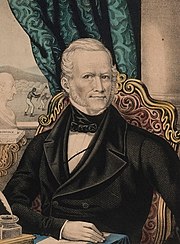
ThoughWilliam Lloyd Garrisonand most other abolitionists of the 1830s had generally shunned the political system, a small group ofabolitionistsfounded theLiberty Partyin 1840. The Liberty Party was athird partydedicated to the immediate abolition ofslavery.The Liberty Party nominatedJames G. Birneyfor president andThomas Earlefor vice president in the1840 presidential election.[3]Months after the 1840 election, the party re-nominated Birney for president, established a national party committee, and began to organize at the state and local level.[4]Support for the party grew in the North, especially amongevangelicalformerWhigsin New England, upstate New York, Michigan, and Ohio'sWestern Reserve.[5]Other anti-slavery Whigs likeJohn Quincy Adamsremained within the Whig Party, but increasingly supported anti-slavery policies like the repeal of thegag rule,which prevented the House of Representatives from considering abolitionist petitions.[6]Meanwhile, long-time abolitionist leaders likeLewis Tappanbecame increasingly open to working within the political system.[7]In a reflection of the rise of anti-slavery sentiment, several Northern states passedpersonal liberty lawsthat forbid state authorities from cooperating in the capture and return of fugitive slaves.[8]
Beginning in May 1843, PresidentJohn Tylermade theannexation of Texashis key priority. Most leaders of both parties opposed opening the question of annexation in 1843 due to their fear of stoking the debate over slavery; the annexation of Texas was widely viewed as a pro-slavery initiative because it would add another slave state to the union.[9]Nonetheless, in April 1844, Secretary of StateJohn C. Calhounreached a treaty with Texas providing for the annexation of that country.[10]Henry ClayandMartin Van Buren,the two front-runners for the major party presidential nominations in the1844 presidential election,both announced their opposition to annexation, and the Senate blocked the treaty.[11]To the surprise of Clay and other Whigs, the1844 Democratic National Conventionrejected Van Buren in favor ofJames K. Polk,and approved a platform calling for the acquisition of both Texas andOregon Country.[12]Polk went on to defeat Clay in a close election, taking 49.5 of the popular vote and a majority of the electoral vote. The number of voters casting a ballot for Birney increased tenfold from 6,200 in 1840 (0.3 percent of popular vote) to 62,000 (2.3 percent of the popular vote) in 1844.[13]
Formation of the Free Soil Party[edit]
Wilmot Proviso[edit]

Following the annexation of Texas in 1845, President Polk began preparations for a potential war withMexico,which still regarded Texas as a part of its republic.[14]After a skirmish known as theThornton Affairbroke out on the northern side of the Rio Grande,[15]Polk convinced Congress to declare war against Mexico.[16]Though most Democrats and Whigs initially supported the war, Adams and some other anti-slavery Whigs attacked the war as a "Slave Power"plot designed to expand slavery across North America.[17]Meanwhile, former Democratic CongressmanJohn P. Halehad defied party leaders by denouncing the annexation of Texas, causing him to lose re-election in 1845. Hale joined with anti-slavery Whigs and the Liberty Party to create a new party in New Hampshire, and he won election to the Senate in early 1847.[18]In New York, tensions between the anti-slaveryBarnburner and the conservative Hunkerfactions of the Democratic Party rose, as the Hunkers allied with the Whigs to defeat the re-election campaign of Democratic GovernorSilas Wright.[19]
In August 1846, Polk asked Congress to appropriate $2 million (~$60.7 million in 2023) in hopes of using that money as a down payment for the purchase ofAlta Californiain a treaty with Mexico.[20]During the debate over the appropriations bill, Democratic CongressmanDavid Wilmotof Pennsylvania offered an amendment known as theWilmot Proviso,which would ban slavery in any newly acquired lands.[21]Though broadly supportive of the war, Wilmot and some other anti-slavery Northern Democrats had increasingly come to view Polk as unduly favorable toSoutherninterests, partly due to Polk's decision to compromise with Britain over thepartition of Oregon.[22]Unlike some Northern Whigs, Wilmot and other anti-slavery Democrats were largely unconcerned by the issue of racial equality, and instead opposed the expansion of slavery because they believed the institution was detrimental to the "laboring white man."[23]The Wilmot Proviso passed the House with the support of both Northern Whigs and Northern Democrats, breaking the normal pattern of partisan division in congressional votes, but it was defeated in the Senate, where Southerners controlled a proportionally higher share of seats.[24]Several Northern congressmen subsequently defeated an attempt by President Polk and SenatorLewis Cassto extend theMissouri Compromiseline to the Pacific.[25]
In February 1848, Mexican and U.S. negotiators reached theTreaty of Guadalupe Hidalgo,which provided for the cession of Alta California and New Mexico.[26]Though many senators had reservations about the treaty, the Senate approved it in a 38-to-14 vote in February 1848.[27]SenatorJohn M. Clayton's effort to reach a compromise over the status of slavery in the territories was defeated in the House, ensuring that slavery would be an important issue in the 1848 election.[28]
Election of 1848[edit]

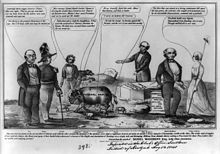
Led byJohn Van Buren,the Barnburners bolted from the1848 Democratic National Conventionafter the party nominated a ticket consisting of Senator Lewis Cass of Michigan and former CongressmanWilliam O. Butlerof Kentucky; Cass and Butler had both opposed the Wilmot Proviso.[29]Shortly after the Democrats nominated Cass, a group of Whigs made plans for a convention of anti-slavery politicians and activists in case the1848 Whig National Conventionnominated GeneralZachary Taylorof Louisiana for president.[30]With the strong backing of slave state delegates, Taylor defeated Henry Clay to win the Whig presidential nomination.[31]For vice president, the Whigs nominated Millard Fillmore of New York, a conservative Northerner.[32]The nomination of Taylor, a slaveholder without any history in the Whig Party, spurred anti-slavery Whigs to go through with their convention, which would meet inBuffalo, New York,in August.[33]A faction of the Liberty Party led bySalmon P. Chaseagreed to attend the convention, though another faction of the party, led byGerrit Smith,refused to consider merging with another party.[34]
Meanwhile, Barnburners convened inUtica, New York,on June 22; they were joined by a smaller number of Whigs and Democrats from outside New York. Though initially reluctant to accept to run for president, former President Van Buren accepted the group's presidential nomination. Van Buren endorsed the position that slavery should be excluded from the territories acquired from Mexico, further declaring his belief that slavery was inconsistent with the "principles of theRevolution".Because Van Buren had favored the gag rule and had generally accommodated pro-slavery leaders during his presidency, many Liberty Party leaders and anti-slavery Whigs were unconvinced as to the sincerity of Van Buren's anti-slavery beliefs.[35]Historian A. James Reichley writes that, while resentment stemming from his defeat at the 1844 Democratic National Convention may have played a role in his candidacy, Van Buren ran on the grounds that "the long-term welfare of [the Democratic Party], and the nation, required that the [Democratic Party] shed its Calhounite influence, even at the cost of losing an election or two."[36]
With mix of Democratic, Whig, and Liberty Party attendees, theNational Free Soil Conventionconvened in Buffalo early August. Anti-slavery leaders made up a majority of the attendees, but the convention also attracted some Democrats and Whigs who were indifferent on the issue of slavery but disliked the nominee of their respective party.[37]Salmon Chase,Preston King,andBenjamin Franklin Butlerled the drafting of a platform that not only endorsed the Wilmot Proviso but also called for the abolition of slavery inWashington, D.C.,and allU.S. territories.With the backing of most Democratic delegates, about half of the Whig delegates, and a small number of Liberty Party leaders, Van Buren defeated John P. Hale to win the fledgling party's presidential nomination. For vice president, the Free Soil Party nominatedCharles Francis Adams Sr.,the youngest son of the recently deceased John Quincy Adams.[38]
Some Free Soil leaders were initially optimistic that Van Buren could carry a handful of Northern states and force acontingent electionin the House of Representatives, but Van Buren did not win a single electoral vote.[39]However, the nomination of Van Buren alienated many Whigs; except in northern Ohio, most Whig leaders and newspapers rallied around Taylor's candidacy.[40]Ultimately, Taylor won the election with a majority of the electoral vote and a plurality of the popular vote, improving on Clay's 1844 performance in the South and benefiting from the defection of many Democrats to Van Buren in the North.[41]Van Buren won ten percent of the national popular vote and fifteen percent of the popular vote in the Northern states; he received a popular vote total five times greater than that of Birney's 1844 candidacy.[42]Van Buren was the first third-party candidate in U.S. history to win at least ten percent of the national popular vote.[43]Inconcurrent congressional elections,Salmon Chase won election to the Senate and about a dozen Free Soil candidates won election to the House of Representatives.[44]
Between elections, 1849–1852[edit]
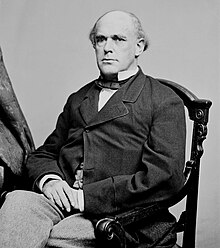

The Free Soil Party continued to exist after 1848, fielding candidates for various offices. At the state level, Free Soilers often entered into coalition with either of the major parties to elect anti-slavery officeholders.[45]To sidestep the issue of the Wilmot Proviso, the Taylor administration proposed that the lands of the Mexican Cession be admitted as states without first organizing territorial governments; thus, slavery in the area would be left to the discretion of state governments rather than the federal government.[46]In January 1850, Senator Clay introduced a separate proposal which included the admission of California as a free state, thecessionby Texas of some of its northern and western territorial claims in return for debt relief, the establishment ofNew MexicoandUtahterritories, a ban on the importation of slaves into the District of Columbia for sale, and a more stringent fugitive slave law.[47]Free Soilers strongly opposed this proposal, focusing especially on thefugitive slave law.[48]
Taylor died in July 1850 and was succeeded by Vice President Fillmore.[49]Fillmore and DemocratStephen A. Douglasled the passage of theCompromise of 1850,which was based on Clay's earlier proposal.[50]The Whig Party became badly split between pro-Compromise Whigs like Fillmore and Webster and anti-Compromise Whigs likeWilliam Seward,who demanded the repeal of the Fugitive Slave Act.[51]The first of several prominent episodes concerning the enforcement of the Fugitive Slave Law occurred in late 1850, when Boston abolitionists helpedEllen and William Craft,two fugitive slaves, escape to Canada.[52]
Though the fugitive slave act and its enforcement outraged anti-slavery activists, most Northerners viewed it as a necessary trade-off for sectional peace with the South, and there was a backlash in the North against the anti-slavery agitation.[53]The Free Soil Party suffered from this backlash, as well as the desertion of many anti-slavery Democrats (including Van Buren himself), many of whom believed that sectional balance had been restored following Van Buren's candidacy and the Compromise of 1850.Charles Sumnerwon election to the32nd Congress,but Free Soilers lost a net of five seats in the1850 and 1851 House of Representatives elections.[54]As the1852 presidential electionapproached, Free Soilers cast about for a candidate. Potential candidates with national stature like Van Buren and SenatorThomas Hart Bentondeclined to run, while Supreme Court JusticeLevi Woodbury,another subject of speculation as a potential Free Soil candidate, died in 1851.[54]
1852 presidential election[edit]
Enforcement of the Fugitive Slave Act damaged Fillmore's standing among Northerners and, with the backing of Senator Seward, GeneralWinfield Scottwon the presidential nomination at the1852 Whig National Convention.[55]The Whig national convention also adopted a platform that endorsed the Compromise of 1850 and the Fugitive Slave Act. Scott and his advisers had initially hoped to avoid openly endorsing the Compromise of 1850 in order to court Free Soil support, but, as a concession to Southern Whigs, Scott agreed to support the Whig platform.[56]The1852 Democratic National Convention,meanwhile, nominated former New Hampshire senatorFranklin Pierce,a Northerner sympathetic to the Southern view on slavery.[57]Free Soil leaders had initially considered supporting Scott, but they organized a national convention after Scott accepted the pro-Compromise Whig platform.[58]
At the August 1852 Free Soil Convention, held inPittsburgh,the party nominated a ticket consisting of Senator John P. Hale of New Hampshire and former CongressmanGeorge Washington Julianof Indiana. The party adopted a platform that called for the repeal of the Fugitive Slave Act and described slavery as "a sin against God and a crime against man."[59]Free Soil leaders strongly preferred Scott to Pierce, and Hale focused his campaign on winning over anti-slavery Democratic voters.[60]The elections proved to be disastrous for the Whig Party, as Scott was defeated by a wide margin and the Whigs lost several congressional and state elections.[61]Hale won just under five percent of the vote, performing most strongly in Massachusetts, Vermont, and Wisconsin.[62]Though much of this drop in support was caused by the return of Barnburners to the Democratic Party, many individuals who had voted for Van Buren in 1848 sat out the 1852 election.[63]In the aftermath of the decisive defeat of the Whigs, many Free Soil leaders predicted an impending realignment that would result in the formation of a larger anti-slavery party that would unite Free Soilers with anti-slavery Whigs and Democrats.[64]
Formation of the Republican Party[edit]

Hoping to spur the creation of atranscontinental railroad,in 1853 Senator Douglas proposed a bill to create an organized territorial government in a portion of the Louisiana Purchase that was north of the 36°30′ parallel, and thus excluded slavery under the terms of the Missouri Compromise. After pro-slavery Southern senators blocked the passage of the proposal, Douglas and other Democratic leaders agreed to a bill that would repeal the Missouri Compromise and allow the inhabitants of the territories to determine the status of slavery.[65]In response, Free Soilers issued theAppeal of the Independent Democrats,a manifesto that attacked the bill as the work of the Slave Power.[66]Overcoming the opposition of Free Soilers, Northern Whigs, and many Democrats, theKansas–Nebraska Actwas passed into law in May 1854.[67]The act deeply angered many Northerners, including anti-slavery Democrats and conservative Whigs who were largely apathetic towards slavery but were upset by the repeal of a thirty-year-old compromise. Pierce's forceful response to protests stemming from the capture of escaped slaveAnthony Burnsfurther alienated many Northerners.[68]
Throughout 1854, Democrats, Whigs, and Free Soilers held state and local conventions, where they denounced the Kansas–Nebraska Act. Many of the larger conventions agreed to nominate a fusion ticket of candidate opposed to the Kansas–Nebraska Act, and some adopted portions of the Free Soil platform from 1848 and 1852. One of these groups met inRipon, Wisconsin,and agreed to establish a new party known as theRepublican Partyif the Kansas–Nebraska Act passed. Though many Democrats and Whigs involved in theanti-Nebraska movementstill clung to their partisan affiliation, others began to label themselves as Republicans.[69]Another political coalition appeared in the form of the nativist and anti-CatholicKnow Nothingmovement, which formed the American Party.[70]While the Republican Party almost exclusively appealed to Northerners, the Know Nothings gathered many adherents in both the North and South; some individuals joined both groups even while they remained part of the Whig Party or the Democratic Party.[71]
Congressional Democrats suffered huge losses in the mid-termelections of 1854,as voters provided support to a wide array of new parties opposed to the Democratic Party.[72]Most victorious congressional candidates who were not affiliated with the Democratic Party had campaigned either independently of the Whig Party or in fusion with another party.[73]"Bleeding Kansas",a struggle between anti-slavery and pro-slavery settlers for control ofKansas Territory,escalated in 1855 and 1856, pushing many moderate Northerners to join the nascent Republican Party.[74]As cooperation between Northern and Southern Whigs appeared to be increasingly impossible, leaders from both sections continued to abandon the party.[75]In September 1855, Seward led his faction of Whigs into the Republican Party, effectively marking the end of the Whig Party as an independent and significant political force.[76]In May 1856, after denouncing the Slave Power in a speech on the Senate floor, Senator Sumner wasattackedby CongressmanPreston Brooks,outraging Northerners.[77]Meanwhile, the1856 American National Conventionnominated former President Fillmore for president, but many Northerners deserted the American Party after the party platform failed to denounce the Kansas–Nebraska Act.[78]
The1856 Republican National Conventionconvened in Philadelphia in June 1856. A committee chaired by David Wilmot produced a platform that denounced slavery, the Kansas–Nebraska Act, and the Pierce administration. Though Chase and Seward were the two most prominent members of the nascent party, the Republicans instead nominatedJohn C. Frémont,the son-in-law of Thomas Hart Benton and a political neophyte. The party campaigned on a new version of an old Free Soil slogan: "Free Speech, Free Press, Free Men, Free Labor, Free Territory, and Frémont".[79]With the collapse of the Whig Party, the1856 presidential electionbecame a three-sided contest between Democrats, Know Nothings, and Republicans.[80]During his campaign, Fillmore minimized the issue of nativism, instead attempting to use his campaign as a platform for unionism and a revival of the Whig Party.[81]Ultimately, DemocratJames Buchananwon the election with a majority of the electoral vote and 45 percent of the popular vote; Frémont won most of the remaining electoral votes and took 33 percent of the popular vote, while Fillmore won 21.6 percent of the popular vote and just eight electoral votes.[82]Frémont carried New England, New York, and parts of the Midwest, but Buchanan nearly swept the South and won several Northern states.[83]
Ideology and positions[edit]
The 1848 Free Soil platform openly denounced the institution of slavery, demanding that the federal government "relieve itself of all responsibility for the existence and continuance of slavery" by abolishing slavery in all federal districts and territories. The platform declared: "[W]e inscribe on our banner, 'Free Soil, Free Speech, Free Labor, and Free Men,' and under it we will fight on, and fight forever, until a triumphant victory shall reward our exertions". Unlike the Liberty Party, the 1848 Free Soil Party platform did not address fugitive slaves or racial discrimination, nor did it call for the abolition of slavery in the states. The party nonetheless earned the support of many former Liberty Party leaders by calling for abolition wherever possible, the chief goal of the Liberty Party. The Free Soil platform also called for lowertariffs,reduced postal rates, and improvements to harbors.[84]The 1852 party platform more overtly denounced slavery, and also called for the diplomatic recognition ofHaiti.[59]Many Free Soilers also supported thetemperance movement.[85]
Base of support[edit]

During the 1848 election, the Free Soil Party fared best in New York, Vermont, and Massachusetts.[86]Though some anti-slavery Democrats found Cass acceptable or refused to vote for a ticket featuring Charles Francis Adams, about three-fifths of the support for Van Buren's candidacy came from Democrats. About one-fifth of those who voted for Van Buren were former members of the Liberty Party, though a small number of Liberty Party members voted for Gerrit Smith instead. Except in New Hampshire and Ohio, relatively few Whigs voted for Van Buren,[87]as slavery-averse Whigs likeAbraham Lincoln,Thaddeus Stevens,andHorace Greeleylargely backed Taylor.[42]
In New England, many trade unionists and land reformers supported the Free Soil Party, though others viewed slavery as a secondary issue or were hostile to the anti-slavery movement.[88]Other Free Soil Party supporters were active in thewomen's rightsmovement, and a disproportionate number of those who attended theSeneca Falls Conventionwere associated with party. One leading women's rights activist,Elizabeth Cady Stanton,was the wife of Free Soil leaderHenry Brewster Stantonand a cousin of Free Soil CongressmanGerrit Smith.[89]
Party leaders and other prominent individuals[edit]

Former President Martin Van Buren of New York and Senator John P. Hale of New Hampshire served as the two presidential nominees of the party, while Charles Adams of Massachusetts and Congressman George Washington Julian served as the party's vice-presidential nominees. Salmon P. Chase, Preston King,Gamaliel Bailey,and Benjamin Butler played crucial roles in leading the first party convention and drafting the first party platform. Among those who attended the first Free Soil convention were poet and journalistWalt Whitmanand abolitionist leaderFrederick Douglass,the latter of whom was part of a small group of African Americans to attend the convention.[91]In September 1851, Julian, CongressmanJoshua Reed Giddings,andLewis Tappanorganized a national Free Soil convention that met inCleveland, Ohio.[92]Other notable individuals associated with the party includeCassius Marcellus Clay[93]1876 Democratic presidential nomineeSamuel J. Tilden,SenatorCharles Sumner,educational reformerHorace Mann,poetJohn Greenleaf Whittier,future Montana governorSidney Edgerton,educatorJonathan Blanchard,poetWilliam Cullen Bryant,and writerRichard Henry Dana Jr.[citation needed]
Legacy[edit]
Free Soilers in the Republican Party[edit]
The Free Soil Party essentially merged into the Republican Party after 1854.[94]However, Martin Van Buren (who had already returned to the Democratic Party in November 1852[95]), his followers and theBarnburnersrejoined the Democratic Party.[96][97]Like their Free Soil predecessors, Republican leaders in the late 1850s generally did not call for the abolition of slavery, but instead sought to prevent the extension of slavery into the territories.[94]The Republicans combined the Free Soil stance on slavery with Whig positions on economic issues, such as support for high tariffs and federally-funded infrastructure projects.[98]After 1860, the Republican Party became the dominant force in national politics.[99]Reflecting on the new electoral strength of the Republican Party years later, Free Soiler and anti-slavery activistHenry Brewster Stantonwrote that "the feeble cause I espoused at Cincinnati in 1832...[now rested] on the broad shoulders of a strong party which was marching to victory."[100]
Former Free Soiler Salmon Chase was a major candidate for the presidential nomination at the1860 Republican National Convention,butAbraham Lincolndefeated Chase, Seward, and other candidates to win the party's presidential nomination.[101]After Lincoln won the1860 presidential election,several Southern states seceded, eventually leading to theCivil War.During the war, a faction of the Republican Party known as theRadical Republicansemerged; these Radical Republicans generally went farther than other Republicans in advocating for racial equality and the immediate abolition of slavery.[102]Many of the leading Radical Republicans, including Giddings, Chase, Hale, Julian, and Sumner, had been members of the Free Soil Party.[103]Some Radical Republicans sought replace Lincoln as the 1864 Republican presidential nominee with either Chase or Frémont, but Lincoln ultimately won re-nomination and re-election.[102]In 1865, the Civil War came to an end with the surrender of theConfederacy,and the United States abolished slavery nationwide by ratifying theThirteenth Amendment.Radical Republicans exercised an important influence during the subsequentReconstruction era,calling for ambitious reforms designed to promote the political and economic equality of African Americans in the South.[104]
In 1872, a disproportionate number of former Free Soilers helped found the short-livedLiberal Republican Party,a breakaway group of Republicans who launched an unsuccessful challenge to PresidentUlysses S. Grant's1872 re-electionbid. Aside from defeating Grant, the party's central goals were the end of Reconstruction, the implementation ofcivil service reform,and the reduction of tariff rates.[105]Former Free Soiler Charles Francis Adams led on several presidential ballots of the1872 Liberal Republican convention,but was ultimately defeated byHorace Greeley.[106]Many other former Free Soilers remained in the Republican Party, including former Free Soil CongressmanHenry Wilson,who served as vice president from 1873 until his death 1875.[107]
Memorials[edit]
Free Soil Township, Michigan,was named after the Free Soil party in 1848.[108]
Recent revival[edit]
In 2014, the party's name was used for the American Free Soil Party with a focus on justice for immigrants, as well as combating discrimination.[109]On February 15, 2019, the American Free Soil Party won ballot access for its first candidate to run under its banner in a partisan race when Dr. James W. Clifton filed to run for town council inMillersburg, Indiana.[110]The following day, the party held its national convention and nominated its 2020 presidential ticket, former Southwick Commissioner Adam Seaman of Massachusetts and Dr. Enrique Ramos of Puerto Rico for president and vice president, respectively.[111]On November 5, Clifton lost his race 47% to 53%.[112][113]
Electoral history[edit]
Presidential elections[edit]
| Election | Candidate | Running mate | Vote | |||||
|---|---|---|---|---|---|---|---|---|
| Candidate (Birth–death) |
Home State |
Running mate (Birth–death) |
Home State |
PV% | EV% | |||
| 1848 | Martin Van Buren (1782–1862) |
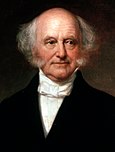
|
NY | Charles Francis Adams Sr. (1807–1886) |

|
MA | 10.1% | 0% |
| 1852 | John P. Hale (1806–1873) |

|
NH | George W. Julian (1817–1899) |

|
IN | 4.9% | 0% |
Members of Congress[edit]
Senators
- Lawrence Brainerd(VT)
- Salmon P. Chase(OH)
- Francis Gillette(CT)
- John P. Hale(NH)
- Charles Sumner(MA)
- Henry Wilson(MA)
Members of the House of Representatives
- Charles Allen(MA)
- Walter Booth(CT)
- Alexander De Witt(MA)
- Charles Durkee(WI)
- Joshua Reed Giddings(OH)
- Edward Wade(OH)
- John W. Howe(PA)
- George Washington Julian(IN)
- Preston King(NY)
- Horace Mann(MA)
- Joseph M. Root(OH)
- Gerrit Smith(NY)
- Amos Tuck(NH)
Congressional party divisions, 1849–1855[edit]
| Congress | Years | Senate[114] | House of Representatives[115] | President | ||||||||||
|---|---|---|---|---|---|---|---|---|---|---|---|---|---|---|
| Total | Democrats | Whigs | Free Soil | Total | Democrats | Whigs | Free Soil | Others | ||||||
| 31st | 1849–1851 | 62 | 35 | 25 | 2 | 233 | 113 | 108 | 9 | 2 | Zachary Taylor[b] | |||
| 32nd | 1851–1853 | 62 | 36 | 23 | 3 | 233 | 127 | 85 | 4 | 17 | Millard Fillmore | |||
| 33rd | 1853–1855 | 62 | 38 | 22 | 2 | 234 | 157 | 71 | 4 | 2 | Franklin Pierce | |||
See also[edit]
Notes[edit]
- ^The Free Soil Party sought to exclude slavery fromU.S. territories,thereby preventing the addition of newslave states.However, the party did not call for abolition of slavery in states where it already existed.
- ^President Taylor died July 9, 1850, about one year and four months into the term, and was succeeded byMillard Fillmore,who served for the remainder of the term.
References[edit]
- ^Foner, Eric (April 20, 1995).Free Soil, Free Labor, Free Men: The Ideology of the Republican Party before the Civil War.Oxford University Press.ISBN9780195094978.
- ^Ohio History Central."Free Soil Party".Ohio History Connection.RetrievedAugust 3,2017.
- ^Wilentz (2005) pp. 478–479
- ^Wilentz (2005) p. 548
- ^Holt (1999), pp. 155–156.
- ^Wilentz (2005) pp. 554–555
- ^Wilentz (2005) pp. 550–551
- ^Wilentz (2005) p. 590
- ^Holt (1999), pp. 169–170.
- ^Holt (1999), pp. 170–171.
- ^Holt (1999), pp. 171–172.
- ^Holt (1999), pp. 172–173.
- ^Holt (1999), pp. 194–197.
- ^Merry (2009), pp. 188–189.
- ^Merry (2009), pp. 240–242.
- ^Merry (2009), pp. 244–245.
- ^Wilentz (2005) pp. 582–583
- ^Wilentz (2005) pp. 584–585
- ^Wilentz (2005) pp. 593, 608
- ^Merry (2009), pp. 283–285.
- ^Merry (2009), pp. 286–289.
- ^Wilentz (2005), pp. 593–595
- ^Wilentz (2005), pp. 597–598
- ^McPherson (2003), pp. 53–54.
- ^Wilentz (2005) pp. 605–606
- ^Merry (2009), pp. 424–426.
- ^Wilentz (2005) pp. 613–614
- ^Holt (1999), pp. 335–338
- ^Wilentz (2005) pp. 615–616
- ^Holt (1999), p. 333
- ^Holt (1999), pp. 323–326.
- ^Smith 1988,pp. 22–23.
- ^Wilentz (2005) p. 617
- ^Rosenstone et al. (2018), pp. 50–51
- ^Wilentz (2005) pp. 618–620
- ^Reichley (2000) p. 86
- ^Wilentz (2005) pp. 623–624
- ^Wilentz (2005) pp. 624–626
- ^Wilentz (2005) pp. 627–629
- ^Holt (1999), pp. 340–343
- ^Holt (1999), pp. 368–370.
- ^abWilentz (2005) pp. 628–631
- ^Rosenstone et al. (2018), Appendix A
- ^Wilentz (2005) pp. 631, 637
- ^Brooks (2016), pp. 171–173
- ^Holt (1999), pp. 437–438.
- ^Smith 1988,pp. 111–112.
- ^Brooks (2016), p. 163
- ^Smith 1988,pp. 157–158.
- ^Wilentz (2005) pp. 642–643
- ^Holt (1999), pp. 552–553.
- ^Wilentz (2005) pp. 645–647
- ^Wilentz (2005) pp. 650–652
- ^abWilentz (2005) pp. 659–660
- ^Smith 1988,pp. 239–247.
- ^Gienapp (1987), pp. 18–19
- ^Smith 1988,pp. 237–239, 244.
- ^Gienapp (1987), pp. 19–20
- ^abWilentz (2005) pp. 663–664
- ^Holt (1999), p. 741
- ^Holt (1999), pp. 754–755.
- ^Wilentz (2005) pp. 665–666
- ^Holt (1999), pp. 760–761
- ^Gienapp (1987), pp. 32–33
- ^Wilentz (2005) pp. 671–672
- ^Wilentz (2005) pp. 673–674
- ^Wilentz (2005) pp. 674–675
- ^Wilentz (2005) pp. 675–677
- ^Wilentz (2005) p. 679
- ^Holt (1999), pp. 804–805.
- ^Holt (1999), pp. 843–846.
- ^McPherson (1988), pp. 129–130.
- ^Holt (1999), pp. 877–878.
- ^Wilentz (2005) pp. 685–688
- ^Holt (1999), pp. 907–910.
- ^Holt (1999), pp. 947–949.
- ^Wilentz (2005) pp. 690–691
- ^Wilentz (2005) pp. 693–695
- ^Wilentz (2005) pp. 695–696
- ^Holt (1999), pp. 961–962.
- ^Gara (1991), pp. 175–176.
- ^Holt (1999), pp. 978–980.
- ^Wilentz (2005) pp. 701–702
- ^Wilentz (2005) pp. 624–627, 661
- ^Gienapp (1987), pp. 53–54
- ^Wilentz (2005) pp. 629–630
- ^Rayback (2015), pp. 299–300
- ^Wilentz (2005) pp. 721–722
- ^Wilentz (2005) pp. 620–622
- ^Wilentz (2005) p. 663
- ^Wilentz (2005) pp. 623–624, 626
- ^Wilentz (2005) p. 661
- ^Downey (1967), p. 731
- ^abMcPherson (1988), p. 129.
- ^"Van Buren Timeline".Papers of Martin Van Buren.Archived fromthe originalon 2022-04-17.Retrieved2022-05-21.
- ^Joel H. Silbey (2002).Martin Van Buren and the emergence of American popular politics.Rowman & Littlefield. p. 203.ISBN978-0-7425-2243-5.
- ^Bray, Frank Chapin (1937).Headlines in American History.Thomas Y. Crowell Company. p. 97.
- ^Reichley (2000) pp. 96, 100
- ^Reichley (2000) p. 114
- ^Wilentz (2005) p. 746
- ^Reichley (2000) pp. 102–103
- ^abReichley (2000) p. 108
- ^Shortreed (1959), pp. 67–68
- ^Shortreed (1959), pp. 79–80
- ^Slap (2010), pp. 24–26, 51
- ^Downey (1967), pp. 744–747
- ^"Henry Wilson, 18th Vice President (1873-1875)".United States Senate.RetrievedNovember 5,2019.
- ^Boughner, Eliane Durnin (June 25, 1981)."Free Soil Gets History Write-up".Ludington Daily News.Ludington, MI.RetrievedSeptember 13,2016.
- ^Seaman, Adam (24 November 2018)."Former Prohibition Party Member Reforms American Free Soil Party".American Third Party Report.
- ^"Rev. Dr. James Clifton, ASFP National Director, Running for Millersburg, IN Town Council".
- ^"American Free Soil Party Nominates Its 2020 Presidential Election Candidates".
- ^"American Free Soil Party Candidate Gets 47% of Vote".8 November 2019.
- ^"Archived copy".Archived fromthe originalon 2020-02-28.Retrieved2019-11-10.
{{cite web}}:CS1 maint: archived copy as title (link) - ^"Party Division".United States Senate.
- ^"Party Divisions of the House of Representatives, 1789 to Present".United States House of Representatives.
Works cited[edit]
- Brooks, Corey M. (2016).Liberty Power: Antislavery Third Parties and the Transformation of American Politics.University of Chicago Press.ISBN9780226307282.
- Downey, Matthew T. (1967). "Horace Greeley and the Politicians: The Liberal Republican Convention in 1872".The Journal of American History.53(4): 727–750.doi:10.2307/1893989.JSTOR1893989.
- Gara, Larry (1991).The Presidency of Franklin Pierce.University Press of Kansas.ISBN0-7006-0494-4.
- Gienapp, William E. (1987).The Origins of the Republican Party, 1852-1856.Oxford University Press.ISBN9780198021148.
- Holt, Michael F. (1999).The Rise and Fall of the American Whig Party: Jacksonian Politics and the Onset of the Civil War.Oxford University Press.ISBN0-19-505544-6.
- McPherson, James (2003) [1988].The Illustrated Battle Cry of Freedom: The Civil War Era.Oxford University Press.ISBN978-0-19-974390-2.
- Merry, Robert W. (2009).A Country of Vast Designs: James K. Polk, the Mexican War, and the Conquest of the American Continent.Simon & Schuster.ISBN978-0-7432-9743-1.
- Rayback, Joseph G. (2015).Free Soil: The Election of 1848.University of Kentucky.ISBN9780813164434.
- Reichley, A. James (2000) [1992].The Life of the Parties: A History of American Political Parties(Paperback ed.). Rowman & Littlefield Publishers.ISBN0-7425-0888-9.
- Rosenstone, Steven J.; Behr, Roy L.; Lazarus, Edward H. (2018).Third Parties in America: Citizen Response to Major Party Failure(2nd ed.). Princeton University Press.ISBN9780691190525.
- Slap, Andrew L. (2010).The Doom of Reconstruction: The Liberal Republicans in the Civil War Era.Fordham University Press.ISBN9780823227112.
- Shortreed, Margaret (1959). "The Antislavery Radicals: From Crusade to Revolution 1840-1868".Past & Present(16): 65–87.doi:10.1093/past/16.1.65.JSTOR650153.
- Smith, Elbert B. (1988).The Presidencies of Zachary Taylor & Millard Fillmore.The American Presidency. University Press of Kansas.ISBN978-0-7006-0362-6.
- Wilentz, Sean (2005).The Rise of American Democracy: Jefferson to Lincoln.W. W. Norton & Company.ISBN0-393-05820-4.
Further reading[edit]
- Bergeron, Paul H. (1986).The Presidency of James K. Polk.University of Kansas Press.ISBN978-0-7006-0319-0.
- Blue, Frederick J. (1987).Salmon P. Chase: A Life in Politics.Kent State University Press.ISBN9780873383400.
- Blue, Frederick J. (1973).The Free Soilers: Third Party Politics, 1848–54.University of Illinois Press.ISBN978-0252003080.
- Chamberlain, Adam (2014). "Voter Coordination and the Rise of the Republican Party: Evidence from New England".Social Science History.38(3–4): 311–332.doi:10.1017/ssh.2015.27.JSTOR90017038.S2CID154174772.
- Duberman, Martin (1968).Charles Francis Adams, 1807–1886.Stanford University Press.
- Foner, Eric(1995) [1970].Free Soil, Free Labor, Free Men: The Ideology of the Republican Party before the Civil War.New York: Oxford University Press.ISBN0-19-509497-2.
- Harrold, Stanley (2019).American Abolitionism: Its Direct Political Impact from Colonial Times into Reconstruction.University of Virginia Press.ISBN9780813942308.
- Howe, Daniel Walker (2007).What Hath God Wrought: the Transformation of America, 1815–1848.Oxford University Press.ISBN978-0-19-507894-7.
- Johnson, Reinhard O. (2009).The Liberty Party, 1840-1848: Antislavery Third-Party Politics in the United States.LSU Press.ISBN9780807142639.
- Marshall, Schuyler C. "The Free Democratic Convention of 1852."Pennsylvania History22.2 (1955): 146–167.online
- Mitchell, Thomas G. (2007).Antislavery Politics in Antebellum and Civil War America.Greenwood Publishing Group.ISBN9780275991685.
- Niven, John (1983).Martin Van Buren: The Romantic Age of American Politics.Oxford University Press.ISBN9780195032383.
- Silbey, Joel H.(2009).Party Over Section: The Rough and Ready Presidential Election of 1848.University Press of Kansas.ISBN978-0-7006-1640-4.
- Smith, Theodore Clark (1897).The Liberty and Free Soil Parties in the Northwest.Longmans, Green, and Company.
External links[edit]
- Free Soil Banner– Indianapolis Free Soil newspaper that ran from 1848 to 1854; digitized by the Indianapolis Marion County Public Library
- American Abolitionists and Antislavery Activists– comprehensive list of abolitionist and anti-slavery activists and organizations in the United States, including the Free Soil Party
 Texts on Wikisource:
Texts on Wikisource:
- "Free-Soil Party".Encyclopedia Americana.1920.
- "Free Soil Party".Encyclopædia Britannica(11th ed.). 1911.
- "Free-Soil Party, The".New International Encyclopedia.1905.

